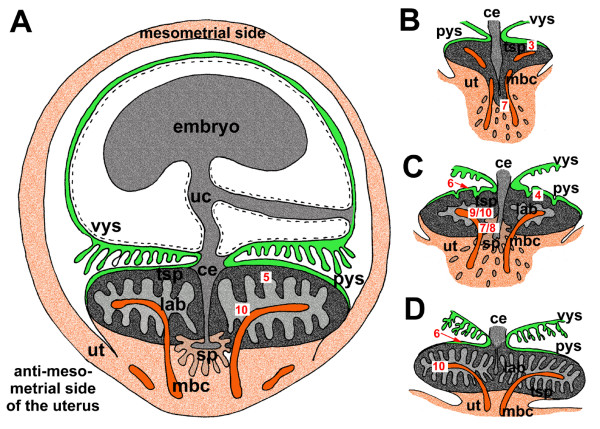File:Fetal membrane and placenta cartoon.jpg
Fetal_membrane_and_placenta_cartoon.jpg (600 × 429 pixels, file size: 125 KB, MIME type: image/jpeg)
Schematic view of the Guinea Pig Fetal Membranes and the Placenta
A The schematic view demonstrates the arrangement of the mesometrially situated embryo, the chorioallantoic placenta, positioned at the antimesometrial side, and the other fetal membranes inside the uterus, representing an advanced stage of pregnancy.
B In initial pregnancy, the placenta contains mainly of trophospongium with the developing subplacenta confluent to the main placenta. Strings of extraplacental trophoblast and syncytial streamers can be followed from towards the maternal blood channels.
C In early pregnancy, a labyrinth is established and the subplacenta represents a distinct organ.
D Near term, the placenta is highly villous with the labyrinth as the dominant area. The subplacenta has been reduced.
Legend
- Red numbers in white boxes refer to subsequent figures with more detailed documentation of specific regions.
- Ce = central excavation
- lab = labyrinth
- mbc = maternal blood channel
- pys = parietal yolk sac
- sp = subplacenta
- sys = syncytial streamers
- tsp = trophospongium
- uc = umbilical cord
- ut = uterine tissue
- vys = visceral yolk sac
Original File Name: 1477-7827-6-39-2.jpg
Paper Abstract: "Placentas of guinea pig-related rodents are appropriate animal models for human placentation because of their striking similarities to those of humans. To optimize the pool of potential models in this context, it is essential to identify the occurrence of characters in close relatives. In this study we first analyzed chorioallantoic placentation in the prea, Galea spixii, as one of the guinea pig's closest relatives. Placentation in Galea is primarily characterized by an apparent regionalization into labyrinth, trophospongium and subplacenta. It also has associated growing processes with clusters of proliferating trophoblast cells at the placental margin, internally directed projections and a second centre of proliferation in the labyrinth. Finally, the subplacenta, which is temporarily supplied in parallel by the maternal and fetal blood systems, served as the center of origin for trophoblast invasion."
Reference
<pubmed>18771596</pubmed>| PMCID: PMC2543018
This is an Open Access article distributed under the terms of the Creative Commons Attribution License (http://creativecommons.org/licenses/by/2.0), which permits unrestricted use, distribution, and reproduction in any medium, provided the original work is properly cited.
File history
Yi efo/eka'e gwa ebo wo le nyangagi wuncin ye kamina wunga tinya nan
| Gwalagizhi | Nyangagi | Dimensions | User | Comment | |
|---|---|---|---|---|---|
| current | 09:21, 16 August 2009 |  | 600 × 429 (125 KB) | S8600021 (talk | contribs) | Schematic view of the fetal membranes and the placenta. (A) The schematic view demonstrates the arrangement of the mesometrially situated embryo, the chorioallantoic placenta, positioned at the antimesometrial side, and the other fetal membranes inside |
You cannot overwrite this file.
File usage
The following 4 pages use this file:
